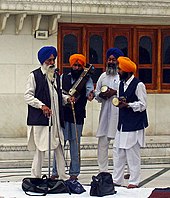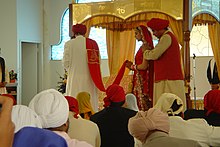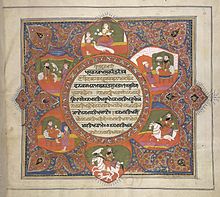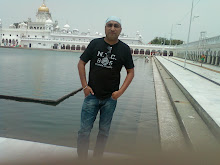Main article: Sikh gurus

A rare Tanjore-style painting from the late 19th century depicting the ten Sikh Gurus with Bhai Bala and Bhai Mardana.
| # | Name | Date of birth | Guruship on | Date of ascension | Age |
|---|---|---|---|---|---|
| 1 | Nanak Dev | 15 April 1469 | 20 August 1507 | 22 September 1539 | 69 |
| 2 | Angad Dev | 31 March 1504 | 7 September 1539 | 29 March 1552 | 48 |
| 3 | Amar Das | 5 May 1479 | 26 March 1552 | 1 September 1574 | 95 |
| 4 | Ram Das | 24 September 1534 | 1 September 1574 | 1 September 1581 | 46 |
| 5 | Arjan Dev | 15 April 1563 | 1 September 1581 | 30 May 1606 | 43 |
| 6 | Har Gobind | 19 June 1595 | 25 May 1606 | 28 February 1644 | 48 |
| 7 | Har Rai | 16 January 1630 | 3 March 1644 | 6 October 1661 | 31 |
| 8 | Har Krishan | 7 July 1656 | 6 October 1661 | 30 March 1664 | 7 |
| 9 | Tegh Bahadur | 1 April 1621 | 20 March 1665 | 11 November 1675 | 54 |
| 10 | Gobind Singh | 22 December 1666 | 11 November 1675 | 7 October 1708 | 41 |
| 11 | Guru Granth Sahib | n/a | 7 October 1708 | n/a | n/a |

The interior of the Akal Takht
The Sikh gurus established a mechanism which allowed the Sikh religion to react as a community to changing circumstances. The sixth guru, Guru Hargobind, was responsible for the creation of the concept of Akal Takht (throne of the timeless one), which serves as the supreme decision-making centre of Sikhism and sits opposite the Darbar Sahib. The Sarbat Ḵẖālsā (a representative portion of the Khalsa Panth) historically gathers at the Akal Takht on special festivals such as Vaisakhi or Diwali and when there is a need to discuss matters that affect the entire Sikh nation. A gurmatā (literally, guru's intention) is an order passed by the Sarbat Ḵẖālsā in the presence of the Gurū Granth Sāhib. A gurmatā may only be passed on a subject that affects the fundamental principles of Sikh religion; it is binding upon all Sikhs.[21] The term hukamnāmā (literally, edict or royal order) is often used interchangeably with the term gurmatā. However, a hukamnāmā formally refers to a hymn from the Gurū Granth Sāhib which is given as an order to Sikhs.

[edit] History
Main article: History of Sikhism
Guru Nanak (1469–1538), the founder of Sikhism, was born in the village of Rāi Bhōi dī Talwandī, now called Nankana Sahib (in present-day Pakistan).[22] His father, Mehta Kalu was a Patwari, an accountant of land revenue in the employment of Rai Bular Bhatti, the area landlord. Nanak's mother was Tripta Devi and he had one older sister, Nanaki. His parents were Khatri Hindus of the Bedi clan. As a boy, Nanak was fascinated by God and religion. He would not partake in religious rituals or customs and oddly meditated alone. His desire to explore the mysteries of life eventually led him to leave home and take missionary journeys.In his early teens, Nanak caught the attention of the local landlord Rai Bular Bhatti, who was moved by his amazing intellect and divine qualities. Rai Bular was witness to many incidents in which Nanak enchanted him and as a result Rai Bular and Nanak's sister Bibi Nanki, became the first persons to recognise the divine qualities in Nanak. Both of them then encouraged and supported Nanak to study and travel. Sikh tradition states that at the age of thirty, Nanak went missing and was presumed to have drowned after going for one of his morning baths to a local stream called the Kali Bein. On the day he arrived, he declared: "There is no Hindu, there is no Muslim" (in Punjabi, "nā kōi hindū nā kōi musalmān"). It was from this moment that Nanak would begin to spread the teachings of what was then the beginning of Sikhism.[23] Although the exact account of his itinerary is disputed, he is widely acknowledged to have made five major journeys, spanning thousands of miles, the first tour being east towards Bengal and Assam, the second south towards Andhra and Tamil Nadu, the third north towards Kashmir, Ladakh, and Tibet, and the fourth tour west towards Baghdad and Mecca.[24] In his last and final tour, he returned to the banks of the Ravi River to end his days.[25]
Nanak was married to Sulakhni, the daughter of Moolchand Chona, a rice trader from the town of Batala. They had two sons. The elder son, Sri Chand, was an ascetic, and he came to have a considerable following of his own, known as the Udasis. The younger son, Lakshmi Das, on the other hand, was immersed in worldly life. To Nanak, who believed in the ideal of rāj maiṁ jōg (detachment in civic life), both his sons were unfit to carry on the Guruship.
Growth of the Sikh community
In 1538, Nanak chose his disciple Lahiṇā, a Khatri of the Trehan clan, as a successor to the guruship rather than either of his sons. Lahiṇā was named Angad Dev and became the second guru of the Sikhs.[26] Nanak conferred his choice at the town of Kartarpur on the banks of the river Ravi, where Nanak had finally settled down after his travels. Though Sri Chand was not an ambitious man, the Udasis believed that the Guruship should have gone to him, since he was a man of pious habits in addition to being Nanak's son. On Nanak's advice, Angad shifted from Kartarpur to Khadur, where his wife Khivi and children were living, until he was able to bridge the divide between his followers and the Udasis. Angad continued the work started by Nanak and is widely credited for standardising the Gurmukhī script as used in the sacred scripture of the Sikhs.Amar Das, a Khatri of the Bhalla clan, became the third Sikh guru in 1552 at the age of 73. Goindval became an important centre for Sikhism during the guruship of Amar Das. He preached the principle of equality for women by prohibiting purdah and sati. Amar Das also encouraged the practice of langar and made all those who visited him attend laṅgar before they could speak to him.[27] In 1567, Emperor Akbar sat with the ordinary and poor people of Punjab to have laṅgar. Amar Das also trained 146 apostles of which 52 were women, to manage the rapid expansion of the religion.[28] Before he died in 1574 aged 95, he appointed his son-in-law Jēṭhā, a Khatri of the Sodhi clan, as the fourth Sikh guru.
Jēṭhā became Ram Das and vigorously undertook his duties as the new guru. He is responsible for the establishment of the city of Ramdaspur later to be named Amritsar. Before Ramdaspur, Amritsar was known as Guru Da Chakk. In 1581, Arjan Dev—youngest son of the fourth guru—became the fifth guru of the Sikhs. In addition to being responsible for building the Darbar/Harimandir Sahib (called the Golden Temple), he prepared the Sikh sacred text known as the Ādi Granth (literally the first book) and included the writings of the first five gurus and other enlightened Hindu and Muslim saints. In 1606, for refusing to make changes to the Granth and for supporting an unsuccessful contender to the throne, he was tortured and killed by the Mughal Emperor, Jahangir.[29]
Political advancement
Hargobind, became the sixth guru of the Sikhs. He carried two swords—one for spiritual and the other for temporal reasons (known as mīrī and pīrī in Sikhism).[30] Sikhs grew as an organized community and under the 10th Guru the Sikhs developed a trained fighting force to defend their independence. In 1644, Har Rai became guru followed by Harkrishan, the boy guru, in 1661. No hymns composed by these three gurus are included in the Guru Granth Sahib.[31]Tegh Bahadur became guru in 1665 and led the Sikhs until 1675. Teg Bahadur was executed by Aurangzeb for helping to protect the faith, after a delegation of Kashmiri Pandits came to him for help when the Emperor was killing those who refused to convert to Islam.[32] He was succeeded by his son, Gobind Rai who was just nine years old at the time of his father's death. Gobind Rai further militarised his followers, and was baptised by the Pañj Piārē when he formed the Khalsa on 13 April 1699. From here on in he was known as Gobind Singh.
From the time of Nanak, when it was a loose collection of followers who focused entirely on the attainment of salvation and God, the Sikh community had significantly transformed. Even though the core Sikh religious philosophy was never affected, the followers now began to develop a political identity. Conflict with Mughal authorities escalated during the lifetime of Teg Bahadur and Gobind Singh. The latter founded the Khalsa in 1699. The Khalsa is a disciplined community that combines its religious purpose and goals with political and military duties.[33] After Aurangzeb killed four of his sons, Gobind Singh sent Aurangzeb the Zafarnamah (Notification/Epistle of Victory).
Shortly before his death, Gobind Singh ordered that the Gurū Granth Sāhib (the Sikh Holy Scripture), would be the ultimate spiritual authority for the Sikhs and temporal authority would be vested in the Khalsa Panth—the Sikh Nation/Community.[18] The first scripture was compiled and edited by the fifth guru, Arjan Dev, in 1604.
A former ascetic was charged by Gobind Singh with the duty of punishing those who had persecuted the Sikhs. After the guru's death, Baba Banda Singh Bahadur became the leader of the Sikh army and was responsible for several attacks on the Mughal empire. He was executed by the emperor Jahandar Shah after refusing the offer of a pardon if he converted to Islam.[34]
The Sikh community's embrace of military and political organisation made it a considerable regional force in medieval India and it continued to evolve after the demise of the gurus. After the death of Baba Banda Singh Bahadur, a Sikh Confederacy of Sikh warrior bands known as misls formed. With the decline of the Mughal empire, a Sikh Empire arose in the Punjab under Maharaja Ranjit Singh, with its capital in Lahore and limits reaching the Khyber Pass and the borders of China. The order, traditions and discipline developed over centuries culminated at the time of Ranjit Singh to give rise to the common religious and social identity that the term "Sikhism" describes.[35]
After the death of Ranjit Singh, the Sikh Empire fell into disorder and was eventually annexed by the United Kingdom after the hard-fought First and Second Anglo-Sikh Wars. This brought the Punjab under the British Raj. Sikhs formed the Shiromani Gurdwara Prabandhak Committee and the Shiromani Akali Dal to preserve Sikhs' religious and political organization a quarter of a century later. With the partition of India in 1947, thousands of Sikhs were killed in violence and millions were forced to leave their ancestral homes in West Punjab.[36] Sikhs faced initial opposition from the Government in forming a linguistic state that other states in India were afforded. The Akali Dal started a non-violence movement for Sikh and Punjabi rights. Jarnail Singh Bhindranwale emerged as a leader of the Damdami Taksal in 1977 and promoted a more militant solution to the problem. In June 1984, Indian Prime Minister Indira Gandhi ordered the Indian army to launch Operation Blue Star to remove Bhindranwale and his followers from the Darbar Sahib. Bhindranwale and his accompanying followers were killed during the army's operations. In October, Indira Gandhi was assassinated by two of her Sikh bodyguards. The assassination was followed by the 1984 Anti-Sikh riots massacre[37] and Hindu-Sikh conflicts in Punjab, as a reaction to Operation Blue Star and the assassin.
Scripture
There is one primary source of scripture for the Sikhs: the Gurū Granth Sāhib. The Gurū Granth Sāhib may be referred to as the Ādi Granth—literally, The First Volume—and the two terms are often used synonymously. Here, however, the Ādi Granth refers to the version of the scripture created by Arjan Dev in 1604. The Gurū Granth Sāhib refers to the final version of the scripture created by Gobind Singh.There are other sources of scriptures such as the Dasam Granth and so called Janamsakhis. These however, have been the subject of controversial debate amongst the Sikh community.
Adi Granth
Main article: Ādi Granth
The Ādi Granth was compiled primarily by Bhai Gurdas under the supervision of Arjan Dev between the years 1603 and 1604.[38] It is written in the Gurmukhī script, which is a descendant of the Laṇḍā script used in the Punjab at that time.[39] The Gurmukhī script was standardised by Angad Dev, the second guru of the Sikhs, for use in the Sikh scriptures and is thought to have been influenced by the Śāradā and Devanāgarī scripts. An authoritative scripture was created to protect the integrity of hymns and teachings of the Sikh gurus and selected bhagats. At the time, Arjan Sahib tried to prevent undue influence from the followers of Prithi Chand, the guru's older brother and rival.[40]The original version of the Ādi Granth is known as the kartārpur bīṛ and is claimed to be held by the Sodhi family of Kartarpur.[citation needed] (In fact the original volume was burned by Ahmad Shah Durrani's army in 1757 when they burned the whole town of Kartarpur.)[citation needed]
Guru Granth Sahib

Gurū Granth Sāhib folio with Mūl Mantra
Main article: Gurū Granth Sāhib
The final version of the Gurū Granth Sāhib was compiled by Gobind Singh in 1678. It consists of the original Ādi Granth with the addition of Teg Bahadur's hymns. The Guru Granth Sahib is considered the Eleventh Guru of the Sikhs.- Punjabi: ਸੱਬ ਸਿੱਖਣ ਕੋ ਹੁਕਮ ਹੈ ਗੁਰੂ ਮਾਨਯੋ ਗ੍ਰੰਥ ।
- Transliteration: Sabb sikkhaṇ kō hukam hai gurū mānyō granth.
- English: All Sikhs are commanded to take the Granth as Guru.
The bulk of the scripture is classified into rāgs, with each rāg subdivided according to length and author. There are 31 main rāgs within the Gurū Granth Sāhib. In addition to the rāgs, there are clear references to the folk music of Punjab. The main language used in the scripture is known as Sant Bhāṣā, a language related to both Punjabi and Hindi and used extensively across medieval northern India by proponents of popular devotional religion.[33] The text further comprises over 5000 śabads, or hymns, which are poetically constructed and set to classical form of music rendition, can be set to predetermined musical tāl, or rhythmic beats.

A group of Sikh musicians at the Golden Temple complex
- Punjabi: ੴ ਸਤਿ ਨਾਮੁ ਕਰਤਾ ਪੁਰਖੁ ਨਿਰਭਉ ਨਿਰਵੈਰੁ ਅਕਾਲ ਮੂਰਤਿ ਅਜੂਨੀ ਸੈਭੰ ਗੁਰ ਪ੍ਰਸਾਦਿ ॥
- ISO 15919 transliteration: Ika ōaṅkāra sati nāmu karatā purakhu nirabha'u niravairu akāla mūrati ajūnī saibhaṅ gura prasādi.
- Simplified transliteration: Ik ōaṅkār sat nām kartā purkh nirbha'u nirvair akāl mūrat ajūnī saibhaṅ gur prasād.
- English: One Universal Creator God, The Name Is Truth, Creative Being Personified, No Fear, No Hatred, Image Of The Timeless One, Beyond Birth, Self Existent, By Guru's Grace.
[edit] Dasam Granth
Main article: Dasam Granth
The Dasam Granth is a scripture of Sikhism which contains some texts attributed to the Tenth Guru. While the Guru Granth Sahib is a religious scripture, the Dasam Granth does not hold religious significance for Sikhs. Some compositions of the Dasam Granth like Jaap Sahib, (Amrit Savaiye), and Benti Chaupai are part of the daily prayers (Nitnem) of Sikhs.Janamsakhis
Main article: Janamsākhīs
The Janamsākhīs (literally birth stories), are writings which profess to be biographies of Nanak. Although not scripture in the strictest sense, they provide an interesting look at Nanak's life and the early start of Sikhism. There are several—often contradictory and sometimes unreliable—Janamsākhīs and they are not held in the same regard as other sources of scriptural knowledge.Observances
Observant Sikhs adhere to long-standing practices and traditions to strengthen and express their faith. The daily recitation from memory of specific passages from the Gurū Granth Sāhib, especially the Japu (or Japjī, literally chant) hymns is recommended immediately after rising and bathing. Family customs include both reading passages from the scripture and attending the gurdwara (also gurduārā, meaning the doorway to God; sometimes transliterated as gurudwara). There are many gurdwaras prominently constructed and maintained across India, as well as in almost every nation where Sikhs reside. Gurdwaras are open to all, regardless of religion, background, caste, or race.Worship in a gurdwara consists chiefly of singing of passages from the scripture. Sikhs will commonly enter the temple, touch the ground before the holy scripture with their foreheads, and make an offering. The recitation of the eighteenth century ardās is also customary for attending Sikhs. The ardās recalls past sufferings and glories of the community, invoking divine grace for all humanity.[42]
The most sacred shrine is the Harimandir Sahib in Amritsar, famously known as the Golden Temple. Groups of Sikhs regularly visit and congregate at the Harimandir Sahib. On specific occasions, groups of Sikhs are permitted to undertake a pilgrimage to Sikh shrines in the province of Punjab in Pakistan, especially at Nankana Sahib and other Gurdwaras. Other places of interest to Sikhism in Pakistan includes the samādhī (place of cremation) of Maharaja Ranjit Singh in Lahore.
The Sikh faith also participates in the custom of "Langar" or the community meal. In the afternoon, all temples are open to anyone of any faith for a free meal. People can enter and eat together and are served by faithful members of the community. This is the main cost associated with gurdwaras and where monetary donations are primarily spent.
Sikh festivals
Festivals in Sikhism mostly centre around the lives of the Gurus and Sikh martyrs. The SGPC, the Sikh organisation in charge of upkeep of the gurdwaras, organises celebrations based on the new Nanakshahi calendar. This calendar is highly controversial among Sikhs and is not universally accepted. Several festivals (Hola Mohalla, Diwali, and Nanak's birthday) continue to be celebrated using the Hindu calendar. Sikh festivals include the following:- Gurpurabs are celebrations or commemorations based on the lives of the Sikh gurus. They tend to be either birthdays or celebrations of Sikh martyrdom. All ten Gurus have Gurpurabs on the Nanakshahi calendar, but it is Guru Nanak Dev and Guru Gobind Singh who have a gurpurab that is widely celebrated in Gurdwaras and Sikh homes. The martyrdoms are also known as a shaheedi Gurpurab, which mark the martyrdom anniversary of Guru Arjan Dev and Guru Tegh Bahadur.
- Vaisakhi or Baisakhi normally occurs on 13 April and marks the beginning of the new spring year and the end of the harvest. Sikhs celebrate it because on Vaisakhi in 1699, the tenth guru, Gobind Singh, laid down the Foundation of the Khalsa an Independent Sikh Identity.
- Bandi Chhor Divas or Diwali celebrates Guru Hargobind's release from the Gwalior Fort, with several innocent Hindu kings who were also imprisoned by Jahangir, on 26 October 1619.
- Hola Mohalla occurs the day after Holi and is when the Khalsa Panth gather at Anandpur and display their warrior skills, including fighting and riding.
Ceremonies and customs

The anand kāraj (Sikh marriage) ceremony
Upon a child's birth, the Guru Granth Sahib is opened at a random point and the child is named using the first letter on the top left hand corner of the left page. All boys are given the middle name Singh, and all girls are given the middle name Kaur.[44] Sikhs are joined in wedlock through the anand kāraj ceremony. Sikhs are required to marry when they are of a sufficient age (child marriage is taboo), and without regard for the future spouse's caste or descent. The marriage ceremony is performed in the company of the Guru Granth Sahib; around which the couple circles four times. After the ceremony is complete, the husband and wife are considered "a single soul in two bodies."[45]
According to Sikh religious rites, neither husband nor wife is permitted to divorce. A Sikh couple that wishes to divorce may be able to do so in a civil court but this is not condoned.[46] Upon death, the body of a Sikh is usually cremated. If this is not possible, any means of disposing the body may be employed. The kīrtan sōhilā and ardās prayers are performed during the funeral ceremony (known as antim sanskār).[47]
Baptism and the Khalsa
Khalsa (meaning "pure") is the name given by Gobind Singh to all Sikhs who have been baptised or initiated by taking ammrit in a ceremony called ammrit sañcār. The first time that this ceremony took place was on Vaisakhi, which fell on 29 March 1698/1699 at Anandpur Sahib in Punjab. It was on that occasion that Gobind Singh baptised the Pañj Piārē who in turn baptised Gobind Singh himself.Baptised Sikhs are bound to wear the Five Ks (in Punjabi known as pañj kakkē or pañj kakār), or articles of faith, at all times. The tenth guru, Gobind Singh, ordered these Five Ks to be worn so that a Sikh could actively use them to make a difference to their own and to others' spirituality. The 5 items are: kēs (uncut hair), kaṅghā (small comb), kaṛā (circular iron bracelet), kirpān (dagger), and kacchā (special undergarment). The Five Ks have both practical and symbolic purposes.[48]
Sikh people
Main article: Sikh
Further information: Sikhism by country
Worldwide, there are 25.8 million Sikhs and approximately 75% of Sikhs live in the Indian state of Punjab, where they constitute about 60% of the state's population. Even though there are a large number of Sikhs in the world, certain countries have not recognised Sikhism as a major religion. Large communities of Sikhs live in the neighboring states, and large communities of Sikhs can be found across India. However, Sikhs only make up about 2% of the Indian population.In addition to social divisions, there is a misperception that there are a number of Sikh sectarian groups,[clarification needed] such as Namdharis and Nirankaris. Nihangs tend to have little difference in practice and are considered the army of Sikhism. There is also a sect known as Udasi, founded by Sri Chand who were initially part of Sikhism but later developed into a monastic order.
Sikh Migration beginning from the 19th century led to the creation of significant communities in Canada (predominantly in Brampton, along with Malton in Ontario and Abbotsford, Mission, Lower Mainland, Surrey in British Columbia), East Africa, the Middle East, Southeast Asia, the United Kingdom as well as Australia and New Zealand. These communities developed as Sikhs migrated out of Punjab to fill in gaps in imperial labour markets.[49] In the early twentieth century a significant community began to take shape on the west coast of the United States. Smaller populations of Sikhs are found in within many countries in Western Europe, Mauritius, Malaysia, Fiji, Nepal, China, Pakistan, Afghanistan, Iraq, Singapore, Mexico and many other countries.
Since 1968, thousands of non-Punjabis have taken up the Sikh belief and lifestyle primarily in the United States, Canada, Latin America, the Far East and Australia. These first and second generation Sikhs are of various ethnic backgrounds and include Caucasians, Blacks, and Chinese.
Sikhism in Sindh
With migration of Sikhs to Sindh because of their persecution by Muslim rulers of Punjab, Sindhis adopted Sikhism. Especially Sindhi ladies learnt Punjabi script to enable them to read Guru Granth Sahib. Many of Amils, a sect of Sindhis, adopted Sikhism. The majority of Sindhi Hindus are Sikhs - followers of the teachings of Guru Nanak. These Sikhs are not to be confused with the Punjabi Sikhs. The Punjabi Singhs follow all the Gurus, including the tenth Guru, Guru Gobind Singh whose influence led to the militarization of the Sikhs. Under this leader Guru Gobind Singh, the followers received new names with the suffix Singh and swore to keep the five Ks - long hair, bangle, comb, shorts and a sabre. Since Guru Nanak was the original leader of this movement and his teachings are still the essence of Sikhism, Sindhis do consider themselves Sikhs but nowadays it is mainly the older generation. In older times, probably at the turn of the century there was an optional custom for the eldest son to take the name Singh and to adopt the 5 Ks.[50]Sikhism found a strong foothold in the Sindh probably because the existing Buddhist influence had paved the way. Buddha was a kshatriya warrior never believed that Brahmins were superior to others. Buddhism itself spread easily in Sindh because of the lack of orthodoxy occasioned by the absence of the Brahmin caste. It was because the beliefs of Guru Nanak emphasised the original spirit of Hinduism without the influence of Brahmins combined with the best of Muslim faith that Sikhism was able to spread quickly.
There used to be a time, when to say one was a non-Muslim Sindhi, was the same as saying he was a Sehajdhari/Nanakpanthi Sikh. During the first decades of this century the Chief Khalsa Diwan of Amritsar sent out missionary groups once a year to Sindh to work amongst the Sehajdhari Sindhis. Over a period of 30 years with scarce resources this missionary actively resulted in a increase from 1000 keshdhari Sindhis in 1901 to over 39,000 in 1941.
The bond of the Sehajdhari Sindhis with Sikhism is legendary. Like the Sikhs of Punjab the Sehajdhari Sikhs of Sindh also left behind their homeland and are now dispersed all over India and abroad. There are about 1.3 million Sindhis in Sindh province of Pakistan and about 2.5 million in India. Their main pilgrimage centres are Nankana Sahib and Dehra Sahib in Pakistani Punjab and Sadh Bela near Sukkur in Sindh. Sadh Bela is an udasi shrine built in 1823.




No comments:
Post a Comment